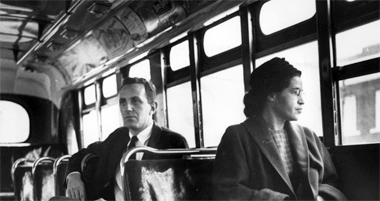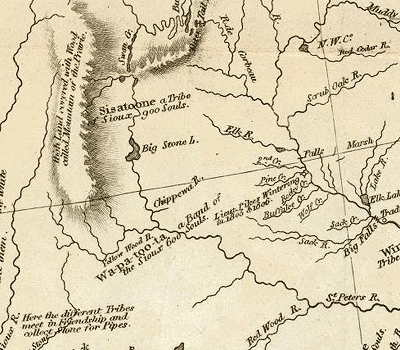October 2005
Contained
From an ITConversations recording of David Rumsey’s presentation at the Where 2.0 Conference, June 29, 2005:
“Land surveys in the 19th century began to help divide the country for settlement and political division by drawing patterns on the land. The notion of ‘land ownership’ invades the West with devastating effects on Native Americans....
Here we can see what happened with Indians in Lewis and Clark’s map of 1814. The Sisseton tribe and the Wahpeton tribe are ranging over large areas of land:
A Map of Lewis and Clark’s Track in 1804, Published 1814.
By 1879, they’ve signed a treaty. And now they’re represented by a polygon:
Rand, McNally & Co.’s Business Atlas Containing Large Scale Maps of Each State and Territory of the United States, The Provinces Of Canada, West India Islands, Etc., Etc. 1878-9.
This is sort of the American Experience.Everything is rationalized, surveyed, contained.”
---
In this post I noted how ideology exists spatially. Rumsey’s example powerfully illustrates how notions and representations of spatiality are themselves ideological. With devastating real world consequences.
Historic Maps Online
While Google Print and the Open Content Alliance have recently been the subject of big headlines about their plans to digitize old books, the David Rumsey Map Collection already has 12,600 historic maps online:
“The collection focuses on rare 18th and 19th century North and South America maps and other cartographic materials. Historic maps of the World, Europe, Asia and Africa are also represented. Collection categories include antique atlas, globe, school geography, maritime chart, state, county, city, pocket, wall, childrens and manuscript maps.”
One can search, view, and juxtapose maps on the Web, as well as download high resolution images in MrSID format. The images are posted under a Creative Commons license. Read more from Rumsey on oreilly.net.
NYPD Trackback
Yesterday saw a hit to this entry in my referer log from ‘ombpxy.nyc.gov’ using a Google Blog search for ‘nypd.’ Is that the NYC Office of Management and Budget?
Given the petty things friends have been arrested for lately, I should probably be more paranoid than I am, but I think this is a good thing.
Not quite eDemocracy (and who knows how the information will be used) but it’s nice to know at least someone’s checking the comments and complaints box.
At least amongst bloggers.
Sing, Sing, Sing
“A pamphlet, no matter how good, is never read more than once, but a song is learned by heart and repeated over and over. And I maintain that if a person can put a few common sense facts into a song and dress them up in a cloak of humor, he will succeed in reaching a great number of workers who are too unintelligent or too indifferent to read.”
— Joe Hill
Longshoreman, wobbly, singer, song-writer, organizer, revolutionary
Type and Empire, 3
From Reuters via CNN:
20 fined for using letters W and Q
Tuesday, October 25, 2005; Posted: 8:05 a.m. EDT (12:05 GMT)
“DIYARBAKIR, Turkey (Reuters) — A Turkish court has fined 20 people for using the letters Q and W on placards at a Kurdish new year celebration, under a law that bans use of characters not in the Turkish alphabet, rights campaigners said.
The court in the southeastern city of Siirt fined each of the 20 people 100 new lira ($75.53) for holding up the placards, written in Kurdish, at the event last year. The letters Q and W do not exist in the Turkish alphabet.
Under pressure from the European Union, Turkey has improved language and human rights for its Kurdish minority, but the EU says implementation has been patchy and loopholes remain.
The 1928 Law on the Adoption and Application of Turkish Letters changed the Turkish alphabet from the Arabic script to a modified Latin script and required all signs, advertising, newspapers and official documents to only use Turkish letters.”
Somehow the suppression of letterforms (and language) still has not washed away the Kurdish culture or the push for autonomy. And, what about those letters E and U?
More on the switch of writing systems later.
Rosa Parks

Lots of blogging and news today about the passing of Rosa Parks today at age 92. Google’s blog search shows well over 15,000 blog posts, so I’m not sure I have much to add. Still, I want to point to both her own words and the organizational context which seems absent from most versions of the story.
This morning Democracy Now today aired an interview with her from 1956, a year after the incident, and shortly before the end of the bus boycott. From it I learned a couple of things:
She was not actually at the front of the bus, but at the front of the ‘Negro section’ of the bus. The routine was that when the ‘white’ part was full, black passengers were expected to give up their seats and stand so that whites could sit.
She was not some young radical, but a full 43 when she refused to stand. Rev. King, on the other hand, was all of 26 that winter.
It was not just her civil disobedience and arrest, but the story of it that catalyzed the larger action. She was not the first to refuse her seat nor to be arrested for it, but the timing was right. Her arrest came just months after the lynching of Emmett Till. At the time, the Women’s Political Council was building a case to challenge Jim Crow laws. The organization had been working for ten years to fight the mistreatment of black bus riders.
Mrs. Parks had been involved with the organization and with the broader civil rights movement, in NAACP and with her church. She was helping prepare for a major NAACP youth conference at the time of her arrest. I suspect her involvement with these networks helped spread the word. The Women’s Council distributed 35,000 flyers urging blacks to boycott the buses on December 5, the day of Mrs. Parks’s trial.
In her own words:
“The driver said that if I refused to leave the seat, he would have to call the police. And I told him, ‘Just call the police.’ He then called the officers of the law. They came and placed me under arrest, violation of the segregation law of the City and State of Alabama Transportation. I didn’t think I was violating any. I felt that I was not being treated right, and that I had a right to retain the seat that I had taken as a passenger on the bus. The time had just come when I had been pushed as far as I could stand to be pushed, I suppose. They placed me under arrest. And I wasn't afraid. I don't know why I wasn’t, but I didn’t feel afraid. I had decided that I would have to know once and for all what rights I had as a human being and a citizen, even in Montgomery, Alabama....
And Monday morning, when the buses were out on the regular run, they remained empty. People were walking or getting rides in cars with people who would pick them up, as best they could. On Monday night, the mass meeting at the Hope Street Baptist Church had been called. And there were many thousand people there. They kept coming, and some people never did get in the church, there was so many.
I was not the only person who had been mistreated and humiliated. I have been refused entrance on the buses because I would not pay my fare at the front and go around to the rear door to enter. That was the custom if the bus was crowded up to the point where the white passengers would start occupying. I hadn’t thought that I would be the person to do this. It hadn’t occurred to me. Others had gone through the same experience, some even worse experience than mine, and they all felt that the time had come, that they should decide that we would have to stop supporting the bus company until we were given better service. And the first day of remaining off the bus had been so successful. It was organized, in that we wouldn’t ride the bus until our request had been granted.”
During the boycott Mrs. Parks was unable to find work in Montgomery — no one would hire her. She moved to Hampton, Virginia and ultimately to Detroit with her husband.
The photo above was taken while she sat on a bus in front of the Supreme Court in November 1956, awaiting the decision that would find segregation on transportation unconstitutional.
Rest in peace, Mrs. Parks.
NYPD v. FDNY
One of the failures of the emergency response on September 11, 2001 was the inability of the New York Police Department and Fire Department to coordinate their activities.
So as a new policy for emergency response was debated, I’d assumed the battle for control in a disaster was one of power between two muscular (mostly) white, male institutions* (mostly) immune from external accountability. Or to put it to a kinder scenario, one of two long-standing, insular city bureaucracies unwilling to bend to the other.
Who would you want in control? One has experience with hazardous materials, the other with crowd control. One carries axes, the other guns.
So what does this have to do with design?
A friend who works for the city put it differently. She cast the dispute in terms of the departments’ relationships to the built environment:
The first response of the NYPD is to quarantine and preserve the evidence at the scene of the crime.
The response of FDNY is to enter forcefully and tear up the scene looking for survivors and hidden fire.
How exactly should they work together?
* As of 2005, FDNY was 92% white and only 28 of the department’s 8,700 firefighters were women. [source] As of 1999, NYPD was 67.4% white and in 2001, 17 percent of sworn personnel were women. [source, source]
Humanism
“To design is to give shape, structure and form to an idea.”
Jennie Winhall, Design Strategist with the UK Design Council, floats a draft definition of design for comment.
It seems reasonable enough, and I’m particularly attracted to the notion of participatory design that includes users in the design process.
But its focus on reason, practicality, and business strategy misses one dimension: the human.
Design proceeds not just from the knowledge of the designer, but from experience. Design is not just an expression of ideas in physical form, but a concrete embodiment of assumptions, values, desires, ideals, dreams, expectations, and prejudices.
Wiebe E. Bijker and John Law put it concisely, “Our technologies mirror our society. They reproduce and embody the complex interplay of professional, technical, economic, and political factors.”
Design is an expression of what (and who) we believe are “normal” of how much we value certain costs over others — financial, social, and political.
But there’s also that additional feedback loop. To paraphrase Winston Churchill, we shape our design, and thereafter our design shapes us. Design both reflects and creates relationships of power and authority — and can be a vehicle for change.
With regards to design as creative problem solving, I would point out that there’s almost always more than one solution to a problem — more than one way to do it, always another world possible. Design shapes the manufacture of the physical world, our interface with it, and, where mediated, with each other. It is formed by and gives form to the culture and images that frame our understanding of the world. Why one solution is picked over another is often as revealing as the solution itself.



